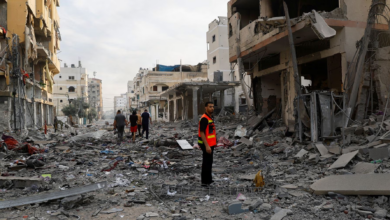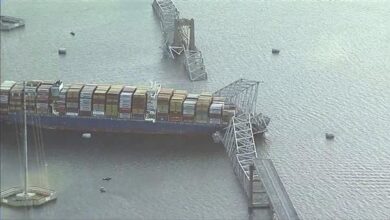Israeli attack destroys thousands of frozen IVF embryos in Gaza
Gaza: The biggest reproductive clinic in Gaza was hit by an Israeli bomb in December, which caused five liquid nitrogen tanks that were kept in an embryology unit corner to burst apart.

At the Al Basma IVF center in Gaza City, almost 4,000 embryos as well as 1,000 more specimens of sperm and unfertilized eggs were destroyed when the very cold liquid evaporated and the temperature inside the tanks increased.
That one blast had a profound effect, serving as an illustration of the hidden cost Israel’s six-and-a-half-month-long assault on Gaza’s 2.3 million residents has exacted.
For hundreds of infertile Palestinian couples, the embryos in those tanks represented their only chance for a happy ending.
“We have a profound understanding of the significance these 5,000 lives, or potential lives, held for the parents, both in the present and the past,” said 73-year-old Bahaeldeen Ghalayini, the obstetrician and gynecologist with training from Cambridge University who founded the clinic in 1997.
According to him, there won’t be another opportunity for at least half of the couples to get pregnant—those who are unable to generate enough sperm or eggs to create healthy embryos.
He murmured, “My heart is split into a million pieces.”
When Reuters inquired about the incident on Wednesday, the Israeli military’s press staff said that it was investigating the claims. Israel has accused Hamas militants of operating out of medical institutions, an accusation that Hamas refutes, while Israel denies deliberately attacking civilian infrastructure.
For Seba Jaafarawi, undergoing reproductive therapy for three years was a psychological roller coaster. Her ovaries had to be removed in a painful procedure, the hormone shots had unpleasant side effects, and the disappointment of not being able to conceive after two unsuccessful attempts at pregnancy felt unfathomable.
When 32-year-old Jaafarawi and her husband were unable to conceive naturally, they resorted to the commonly accessible in vitro fertilization (IVF) procedure in Gaza.
According to the Palestinian Bureau of Statistics, large families are typical in the enclave, where over half of the population is under the age of 18, and the fertility rate is high at 3.38 births per woman. 1.63 births per woman is the fertility rate in Britain.
Couples who are infertile seek IVF despite Gaza’s poverty, with some having to sell jewelry and TVs to cover the costs, according to Al Ghalayini.
There is not much time to rejoice
IVF, in which sperm fertilizes eggs obtained from a woman’s ovaries in a laboratory, was carried out at least nine facilities in Gaza. When the moment is right for transferring the fertilized eggs, or embryos, into a woman’s uterus, they are often frozen. In Gaza, the majority of frozen embryos were kept in the Al Basma center.
September was Jaafarawi’s first successful IVF pregnancy.
She said, “I didn’t even have time to celebrate the news.”
According to Israeli counts, Hamas began the Oct. 7 onslaught on Israel, murdering 1,200 people and kidnapping 253 more, two days before her first planned prenatal exam.
Over 33,000 Palestinians have died as a result of Israel’s all-out assault, which was initiated with the promise to eliminate Hamas, according to Gaza health officials.
“How would I complete my pregnancy?” Jaafarawi fretted. What would become of me and the ones residing inside my womb?
Five more of Jaafarawi’s embryos were kept in storage after Ghalayini closed his practice and her ultrasound never materialized.
The head embryologist at Al Basma, Mohammed Ajjour, became concerned about the liquid nitrogen levels in the five specimen tanks as the Israeli assaults became more intense. Every month or so, top-ups were required to maintain each tank’s temperature below -180 °C since they run without power.
Ajjour was able to get one supply of liquid nitrogen after the conflict started, but most sources shuttered and Israel cut off gasoline and power to Gaza.
Israeli tanks entered Gaza at the end of October, and troops surrounded the IVF center’s streets. Ajjour could no longer safely inspect the tanks.
Jaafarawi knew she needed to take it easy to protect her unsteady pregnancy, but dangers were all around her: the elevator had broken and she had to walk six stories to reach her room; a bomb had destroyed the building next door and shattered the windows in her apartment; food and water were running low.
She fretted rather than rested.
She said, “I became really afraid and there were signs that I would lose the pregnancy.”
After Jaafarawi went south to Khan Younis with her husband, she started to bleed a little bit. Her panic did not go away, but the bleeding did.
“One shell can hold 5,000 people.”
On November 12, when they entered Egypt, her first ultrasound in Cairo revealed she was expecting twins, who were confirmed to be alive.
However, a few days later, she started to have excruciating cramps, bleed profusely, and her stomach suddenly shifted. Even when she arrived at the hospital, the miscarriage had already started.
“I can still hear the sounds of me crying and screaming at the hospital,” the woman said.
The anguish of loss has persisted.
“Only those who have experienced it know what it’s really like, regardless of what I tell you or what you imagine about how difficult the IVF journey is,” she said.
Jaafarawi desired to take her frozen embryos back to the combat zone and try IVF once more.
However, it came too late.
According to Ghalayini, an Israeli shell hit the center’s corner, destroying the embryology lab on the bottom level. He’s not sure whether the assault was directed against the lab in particular.
“Five thousand lives in one shell were all killed or taken away,” he said.
A Reuters-commissioned journalist who visited the scene in April said that the embryology lab was still littered with shattered masonry, blown-up lab equipment, and the liquid nitrogen tanks among the debris.
The tanks’ lids were ajar, revealing a basket at the base of one that held the shattered, minuscule embryos in small, color-coded straws.







